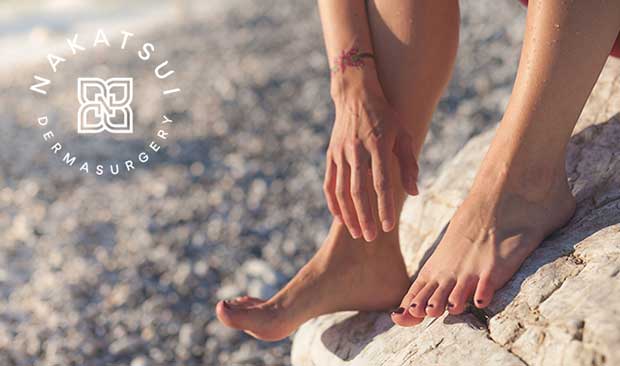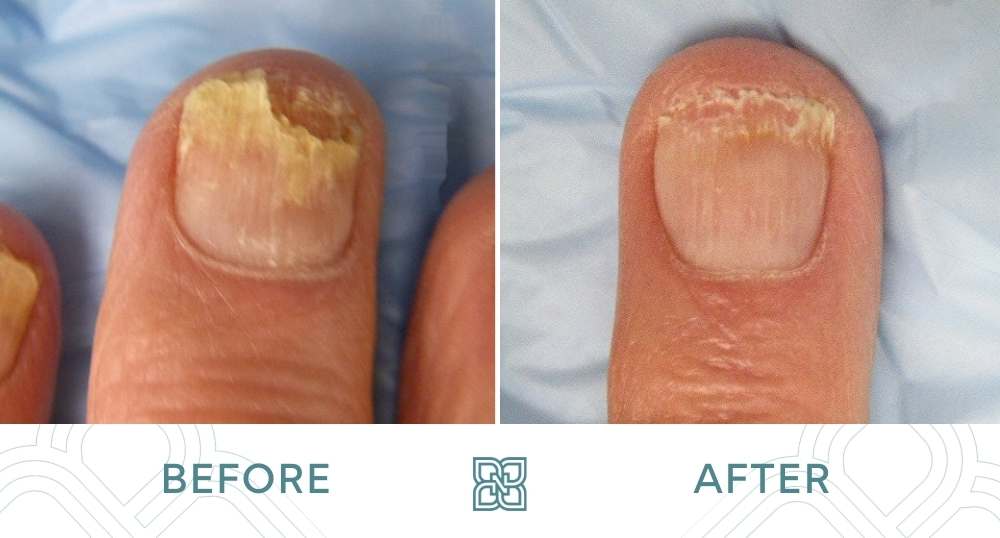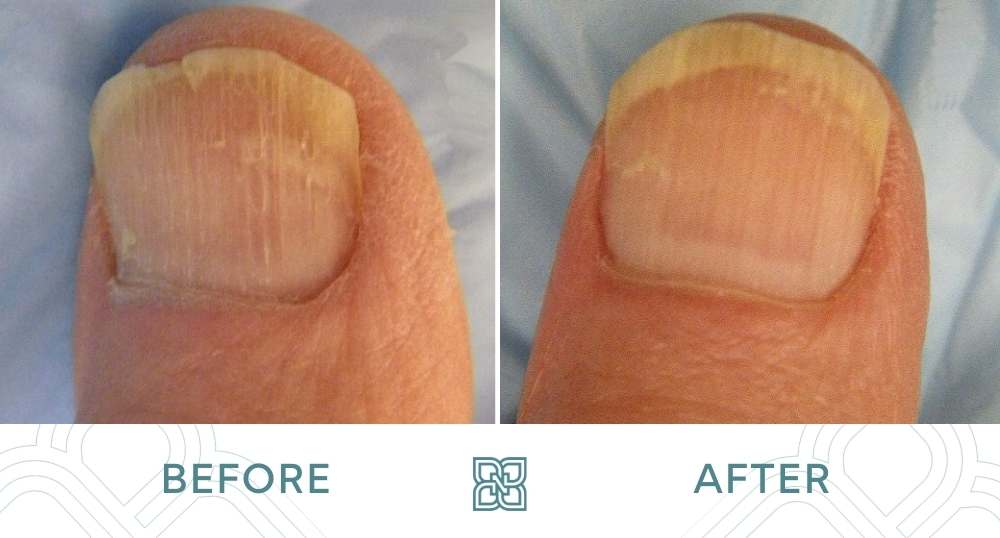
Onychomycosis (Nail Fungus) Treatment

Nail fungus (otherwise known as onychomycosis) is very common and can be very difficult to eradicate
What are the signs and symptoms of nail fungus?
If you notice any of the following signs of change in your nails your may have nail fungus:
- Yellow or brown discoloration
- White or yellow streaks on the side of the nail
- Brittleness
- Change in nail shape
- Crumbling of the outside edges of the nail
- Debris trapped under the nail
- Loosening or lifting up of the nail
- Loss of luster and shine
- Thickening of the nail
- Toes or fingers that are painful, red, or drain pus
The diagnosis of a nail fungal infection is confirmed by scraping or clipping some of the nail for analysis under a microscope at the lab or sending it for a culture which may take up to 4 weeks for the results. Problems that can mimic nail fungus infections include psoriasis and some systemic conditions therefore confirmation is important.
What causes fungal nail infections?
Fungal nail infections are usually seen in adults and are often associated with a fungal infection of the feet (athlete’s foot). Toenails are affected more often than fingernails.
Fungi and bacteria are a normal part of our environment. Certain factors contribute to development of a fungal infection of the nails. The offending fungi thrive in warm, moist environments and in people who experience excessive sweating.
Other contributing factors that increase susceptibility to nail fungi include:
- Getting manicures and pedicures at salons that do not sterilize their equipment
- Minor skin or nail injuries
- Nail deformities or nail disease
- Having moist skin for extended periods of time
- Compromised immune system
- Wearing occlusive footwear
What are the treatment options for nail fungus?
Over-the-counter creams and ointments alone usually do not help treat this condition. Jublia is the latest topical agent that can help some patients with nail fungus. Often a prescription for antifungal medicine such as Lamisil, Sporanox, or Nizoral is required. The medicine is taken by mouth for about 3 to 6 months for toenails; a shorter time for fingernails. Due to the nature of the medication, lab tests are necessary to check for potential liver damage. Alcohol cannot be consumed while on this medication. The success rate is approximately 80%. Laser treatments can also be used to help improve the appearance of the nail.
What complications can occur?
- Recurrence of the fungal infection on the nails or in other parts of the body even after successful treatments. Even with successful treatment, it is common for the fungal infection to return.
- No response to treatments – common in 30% of patients.
- Liver damage with oral medication.
- A burn or blister with laser treatments.
- A skin infection.
- Permanent damage to the nails as a result of the fungal infection.
- Prevention is an important part of the long term success of treatments.
- Good general health and hygiene help prevent fungal infections.
- Do not share tools used for manicures and pedicures with friends or family members.
- Seek a salon that uses medical sterilization (autoclave) techniques to clean their manicure and pedicure instruments.
- Keep your skin clean and dry and practice good nail hygiene.
- Wear protective footwear in public spaces such as swimming pools, spas, showers.
- Wash and dry your hands thoroughly after contact with any fungal infection.
- Wear comfortable shoes and socks that breathe.
- Wear clean socks every day.
Before and After Laser Photos


**Actual patients. Individual results may vary.
Frequently Asked Questions
How Does Laser Nail Fungus Treatment Work?
The laser works by shining a gentle, focused light beam on the nail and surrounding skin. This laser beam shines through the nail helping to eliminate the fungus embedded in the nail matrix and nail plate where the nail fungus thrives. This can lead to significant improvement in the appearance of the nails. At this time, we cannot say for certain if laser treatments lead to complete cure of the nail fungus, although many patients do not experience any recurrence of their nail plate changes.
Is The Laser Nail Procedure Painful?
Will I Be Able To Walk After The Laser Nail Fungus Treatment?
The laser nail fungus treatment does not harm living tissue. Patients can simply walk in, have the procedure done, and then walk right out and go back to their normal activities.
What Are The Possible Adverse Effects Of Laser Nail Fungus Treatment?
- This non-ablative laser treatment is a superficial treatment so the skin surrounding the nail is not disturbed although petechia or pin point bruising may occur. This would resolve within 6 to 7 days.
- Although extremely rare, irregular pigmentation, persistent redness, swelling, blisters, infection or scar may occur.
- The treatment may not work. In initial studies using this treatment technique the success rate was 70% after two treatments.
How Long Does The Laser Nail Fungus Treatment Take?
The laser nail fungus treatment usually takes 30 minutes to treat infected nails.
How Do I Prepare For The Treatment?
It is important to remove ALL traces of nail polish from your toes or hands prior to your treatment and to arrive with clean feet. False nails of any type must also be removed and the nail plate thoroughly cleaned of all debris.
When Can I Paint My Nails After The Laser Nail Fungus Treatment?
Nail polish can be re-applied the day after your treatment.
What Is The Cost For The Laser Nail Treatment?
Laser nail treatments cost $300.00 plus GST per session.
Post Treatment Care
- To help prevent re-infection:
- Apply anti-fungal cream 2X per day for approximately 2 weeks to 3 months depending on the severity of the infection.
- Apply anti-fungal powder to all shoes at least 1X per week for at least 1 month.
- Nail polish may be applied 24 hours after treatment.
- The average time interval between treatments is 4 to 6 weeks.
- Due to slow nail growth, results may not be noticeable for 3 to 6 months.
Do you have another question that wasn’t addressed here? Please feel free to contact us with any questions or concerns you may have!
